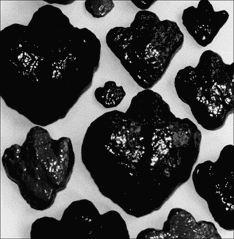 |
|
During the Cretaceous period, which scientists believe took place between sixty and one hundred thirty million years ago, great swamps formed and sluggish streams followed winding, shifting courses to the sea. Luxuriant vegetation, ferns, palms and various hardwood trees grew in profusion along these streams and on adjacent lowlands. This vegetable matter accumulated in the swamp water where partial decomposition took place. The volatile matter was released as gases and the carbonaceous matter was compacted into beds of peat. After burial this matter was transformed into coal. Scientists estimate that it would take one foot of vegetable matter to make one inch of coal. During this time, there developed a group of the most remarkable reptiles the world has ever known, dinosaurs or terrible lizards. They lived on the shores of Cretaceous seas or in the marshes and walked over the forming peat beds leaving their tracks. After the dinosaurs had made their footprints in the marshes, the tracks were filled with sand which hardened and formed casts. How long the sea continued to deposit sand above the coal we do not know, but it was long enough to bury the "lower seam" of coal of the Castle Gate series in Utah under forty feet of sand, which later turned into sandstone. In the Castlegate coal beds certain conditions indicate that continued deposition of sand caused the sea to become shallow, swamps formed, and again the coal forming vegetation flourished which was later buried and turned into coal forming the "middle seam." The sea again overwhelmed the land and another deposit of sand, which is now 140 feet of sandstone, filled the sea. For a third time the swamps and lowlands were covered with lush vegetation, which in time became what is known as the third, or "upper seam" of coal. Two thousand feet or more of sandstone lie above the third seam. Here an enigma is presented. Casts of dinosaur footprints are found in the "lower seam" and in the "upper seam," but are absent from the "middle seam." Did the dinosaurs exist during the entire period? Did those that made the prints on the "lower seam" become extinct? Did other dinosaurs appear when conditions became favorable for the formation of the "upper seam"? If the dinosaurs did live during the entire period, why are footprints absent from the "middle seam"? We may never know the answer to these problems. Following the coal forming periods the land in Carbon and Emery Counties, Utah, was elevated far above sea level. The formations, which contain workable coal beds varying from four to twenty feet in thickness in some instances, are now at an elevation of about seven thousand feet above sea level. Casts of tracks observed in the coal mines, and skeletal remains found elsewhere, indicate that the dinosaurs differed in size, structure and habits. Some were small, others were large. Some walked on four feet, others on strongly developed hind legs as the Trachodon or Duckbill; and the Iguanodon who probably made the three-toed prints; others were four-toed. Some were plant eaters; others fed on flesh. In the coal fields the footprints of the dinosaurs have been discovered where tunnels or entries are extended into the coal seam exposing the casts of tracks on the roof of the mines. An excellent illustration showing the mode of formation and method of discovery of dinosaur tracks may be found on page 467 of Essentials of Earth History, W. L. Stokes (1960), Prentice-Hall. Inc., Englewood Cliffs, New Jersey. Rocks covering these casts may be as much as two thousand feet in thickness. Apparently little thought had been given to collecting these wonderful specimens until 1927 when a few were removed from the No. 3 mine at Standardville, Utah, by C. N. Strevell and the writer. These were added to the Strevell collections. Dinosaur tracks vary greatly in size. In May, 1960, the "D" seam in the Royal Mine, near Castle Gate, Utah, yielded one of the smallest tracks known, measuring 1 1/4 inches long by 3/4 of an inch wide. The largest cast known, from near Thompson, Utah, measuring 4 feet 5 1/2, inches long, was donated to the University of Pennsylvania by R. M. Magraw. In No. 4 Panel of No. 3 mine at Standardville, Utah, an interesting set of over thirty tracks or casts were observed. The dinosaur had traveled this area in an easterly direction and marks where he had dragged and moved his tail from side to side were evident. These tracks were 3 feet 2 inches long. The stride was 10 feet 6 inches and the trackway was 3 feet 8 inches wide. None of these casts were removed but photographs were taken by the Strevell Museum. In the same mine, Mr. Strevell and the writer found four three-toed tracks or casts 2 feet 8 inches long and 2 feet 3 inches wide. The stride was 10 feet 4 inches and the trackway was 3 feet 7 inches wide. Casts of dinosaur footprints, belonging to the Strevell collection, are now on exhibit at the Geology Museum, University of Utah, in Salt Lake City. Additional footprints from the Carbon-Emery County area of Utah may be seen at Carbon College, Price, Utah. Footprints In The Sands Of Time will be on display at the National Gem & Mineral Show in Salt Lake City, Utah, June 19 through 22, 1969. |
